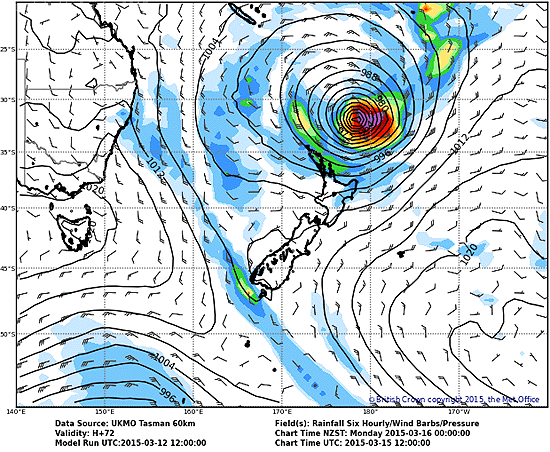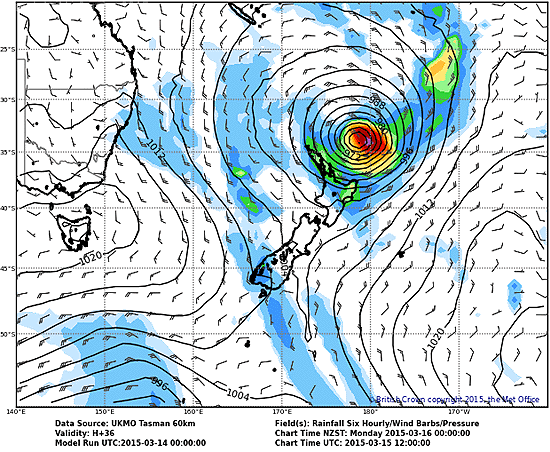
The Metservice is forecasting that Cyclone Pam will hit the top of the North Island hard.
Preparation is called for and although initially a direct hit seemed less likely, the chances may actually be increasing.
Get prepared
Here are a few pointers (from Mercury Energy):
• if there's a weather warning in place charge your phone while you can (and anything else you may need)
• grab a few torches (or candles for mood lighting)
• dig out a thermos or two for keeping boiled water hot
• make sure you can easily access a gas cooker or BBQ for cooking
• plug-in an old-school corded phone as these do not need mains power to work
If the power or hot water goes out:
• contact the appropriate faults line - get the number handy now before the storm arrives
• prepare for power surges. Unplug any sensitive appliances or devices; or use a power surge protector
• check on neighbours to ensure they are safe and comfortable (let’s stick together!)
• if you have people in your home (or neighbourhood) who rely on electricity for medical purposes, please ensure they are safe. If necessary, please contact your healthcare provider or call 111 in an emergency
DAY -5
Here is Metervice's expected situation for Monday, March 16, 2015 as published on March 11, five days out.

DAY -4
Here is the forecast four days out for Monday, March 16, 2015.

And now later in day -4 the forecasters are starting to hedge their projections, pushing it out further east.

DAY -3
Here is the forecast three days out for Monday, March 16, 2015, as published on Friday, March 13, 2015.

Here is the next update for day -3.

DAY -2
Here is the forecast two days out from Monday, March 16, 2015, as published on Saturday, March 14, 2015.

and here is today's second update.

DAY -1
Here is the forecast for tomorrow as published on Sunday, March 15, 2015.


In the end, it has turned out to be a much smaller tropical storm than first warned about having weakened a lot since it wrecked havoc in the south Pacific island nations. However the forecasters have been remarkably accurate in predicting its track.
4 Comments
The storm wont do much for the 2015 vintage. I hope they have got the Gisborne Chardonnay inn.
More severe storms are in line with climate change predictions.
They are picking as fast as they can. Should be zero un-emplyment in Gisborne at the moment.
Predictions from NIWA on effect of climate change on NZ are for increasing drought (particularly in eastern areas), coupled with increasing incidences of more dramatic weather events (a warming atmosphere can hold greater amounts of moisture). So far we have experienced 0.7C of the 2C rise in global temperatures that is already 'baked in' to atmospheric change.
Recent history:
2007 drought in NZ – Low rainfall and significant soil moisture deficits persisted throughout summer and autumn with record low rainfall totals occurring in many northern and eastern areas. This resulted in a severe shortage of feed for livestock, and lower than normal spring lambing and beef numbers, costing more than $500 million.
2008 – Much of New Zealand encountered very dry conditions at the start of 2008, with the Waikato experiencing its driest January in a century. Severe moisture deficits continued throughout the north island until April/May, with the estimated cost to agriculture exceeding $1 billion, and an 11% fall in sheep numbers. Some estimates put the cost as high as $2.8 billion (http://tvnz.co.nz/politics-news/drought-could-cost-nz-2-billion-english…)
2010 – The worst drought in Northland in 60 years occurred when record low rainfall levels were recorded between Nov 2009 and April 2010. Instead of the 748mm which fell during the previous year, only 253 mm fell, leading to parched soils, significantly reduced pasture growth, and decreased farm productivity.
2012/13 - This year's drought was one of New Zealand's most extreme and the worst in nearly 70 years, a study has revealed.It was also one of the most widespread, with only the 1972-73 drought in Wairarapa, Tasman, Otago and Southland coming close in terms of geographical spread.Cost (estimated) $1-2 billion. (http://tvnz.co.nz/politics-news/drought-could-cost-nz-2-billion-english…)
2014/15 - Another drought declared, particularly hard in east of South Island. Cost: as yet unknown, swiftly followed by remnants of cyclone Pam then hitting eastern North islands? (Potential cost to horticulture in Bay of Plenty/Hawkes Bay?)
A few chickens might just be coming home to roost to little old New Zealand. We hear that 'adapt' word a lot (I recall the owner of this website is in the 'adaptation' camp). Seems we might have to 'adapt' to multi billion dollar losses (and getting worse) almost every year.....
Wonder what it will be like when we have gone right past the 2C threshold if this is already what we are experiencing?
And this is only a very mild El Nino.

We welcome your comments below. If you are not already registered, please register to comment.
Remember we welcome robust, respectful and insightful debate. We don't welcome abusive or defamatory comments and will de-register those repeatedly making such comments. Our current comment policy is here.